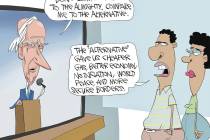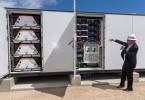COMMENTARY: Data show consumers win with electricity choice
This November, Nevadans will vote on Question 3 to decide whether or not the state will remain a corporate monopoly when it comes to electricity or whether the Legislature should design a new, competitive electricity market. As evidenced by the campaign ads coming from the No on 3 campaign, NV Energy will use scare tactics or unsubstantiated claims featuring estimates or numbers made out of thin air to try to convince Nevadans that the proposal is “risky and costly.”
This is wrong.
I can tell you that neither of those words is an accurate description of competitive consumer choice markets in other states. In fact, we know from actual results from more than a dozen states which have tried retail electricity competition that residential and commercial customers save money.
Retail choice has been around for more than a decade in many parts of the United States. The federal government has made available data that help us determine whether customers have saved money. After analyzing the numbers for the 14 most significant retail choice states, we have calculated that shopping customers have saved $25 billion over the past six years — or an average of $4.1 billion per year.
For residential and commercial customers, from 2011-2016, we looked at the rates that the regulated utility charged and compared them with the rates that these customers received on average from a competitive supply in the same state. All of these 14 states have opened up competition while still allowing customers the option of staying with the regulated utility. Approximately half of sales in these states are being served by the regulated utility while the remainder are served by the competitive supplier community during this study period.
Among these 14 states, the general principles of retail choice are similar. The regulated utilities are required to procure electricity supply for their residential and commercial customers — the utility product is called the default service or standard service option. Utilities are not permitted to earn a profit on the default service option. If regulated utilities can’t earn a profit on this product, a logical question is: How can competitive suppliers offer savings and continue to exist?
This is the beauty of the competitive market. Regulated utilities are required to offer a plain vanilla product that is very rigid and regimented. Utilities must buy power in pre-set amounts and predetermined intervals. Their objective is to offer an option that smooths out some of the inherent volatility in commodity markets. Competitive suppliers have far more flexibility, so they can time the market better than regulated utilities. They can buy more power when it’s cheap and less when its expensive, and they can provide guidance to residential and commercial customers on good and bad buying opportunities. This is the way efficient commodity markets should work.
In this decade, we saw the rise of shale gas and how it has dramatically reduced the cost of electricity supply. In the prior decade, natural gas prices were volatile and as high as $14/per one million British thermal units (MMBtu). Now natural gas prices are $3/MMBtu. Unfortunately, the utility default service product in most states is not designed to react quickly to market conditions. There is a substantial time lag between current wholesale market prices and historical prices.
Of course, that’s not the whole story. Market timing alone cannot explain $25 billion in savings over six years. As is familiar to Nevadans, the regulated utility can have a close relationship with the state commission that is supposed to provide oversight. Also, utility commissioners in several states were afraid to open the electricity market to competition and implemented a series of caps and limits. This combination of fearing the new and wanting to protect the old led to many poor financial outcomes.
Utilities and their government regulators do not have a great track record of predicting future market needs and prices. Utilities spend more effort on making investments to provide reliable electricity service, and they are rewarded for that behavior. In the mid-2000s, utility regulators in the largest states were concerned about rising natural gas prices and implemented price caps. These caps were meant to protect customers from high prices, but the Great Recession hit in 2008, which caused wholesale market prices to plummet. In one market, New Hampshire, the largest utility was saddled with coal plants that were outrageously expensive to operate and maintain, but the utility was permitted to pass through all of these costs to their default service customers.
Regulated utilities do not pay a penalty for their poor decisions because, at the end of the day, the utility regulator always makes them whole. Customers are always footing the bill for utilities’ mistakes. The only way to hold the regulated utility responsible is to break up the monopoly and introduce competitive choice. In the long run, we know from the data that customers will save money.
Young Kim is a principal with the Energy Research Consulting Group.




























